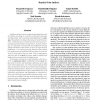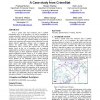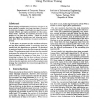103 search results - page 2 / 21 » Faster Joins, Self Joins and Multi-Way Joins Using Join Indi... |
ICDE
2003
IEEE
14 years 6 months ago
2003
IEEE
A plethora of data sources contain data entities that could be ordered according to a variety of attributes associated with the entities. Such orderings result effectively in a ra...
GIS
2008
ACM
14 years 5 months ago
2008
ACM
Given a spatial crime data warehouse, that is updated infrequently and a set of operations O as well as constraints of storage and update overheads, the index type selection probl...
DASFAA
2006
IEEE
13 years 11 months ago
2006
IEEE
An important database primitive for commonly used feature databases is the similarity join. It combines two datasets based on some similarity predicate into one set such that the n...
TSDM
2000
13 years 8 months ago
2000
The growing production of maps is generating huge volume of data stored in large spatial databases. This huge volume of data exceeds the human analysis capabilities. Spatial data m...
VLDB
1991
ACM
13 years 8 months ago
1991
ACM
Shared nothing multiprocessor archit.ecture is known t.obe more scalable to support very large databases. Compared to other join strategies, a hash-ba9ed join algorithm is particu...




